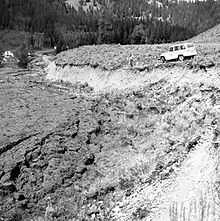

Afault scarp is a small step-like offset of the ground surface in which one side of a fault has shifted vertically in relation to the other.[1][2] The topographic expression of fault scarps results from the differential erosion of rocks of contrasting resistance and the displacement of land surface by movement along the fault.[3][4] Differential movement and erosion may occur either along older inactive geologic faults, or recent active faults.[5][6][7]
Fault scarps often involve zones of highly fractured rock and discontinuities of hard and weak consistencies of rock. Bluffs can form from upthrown blocks and can be very steep, as in the case of Pakistan's coastal cliffs.[8] The height of the scarp formation tends to be defined in terms of the vertical displacement along the fault.[9] Active scarp faults may reflect rapid tectonic displacement[10] and can be caused by any type of fault including strike-slip faults.[11] Vertical displacement of ten meters may occur in fault scarps in volcanic bedrock, but is usually the result of multiple episodic movements of 5 to 10 meters per tectonic event.[12][13]

Due to the dramatic uplift along the fault, which exposes its surface, the fault scarp is very prone to erosion. This is especially true if the material being uplifted consists of unconsolidated sediment.[14] Weathering, mass wasting, and water runoff can soon wear down these bluffs, sometimes resulting in V-shaped valleys along runoff channels. Adjacent V-shaped valley formations give the remaining fault spurs a very triangular shape. This formation is known as a triangular facet; however, this landform is not limited to fault scarps.[15]
Fault scarps may vary in size from a few centimeters to many meters.[16] Fault-line scarps are typically formed due to the differential erosion of weaker rocks along a fault. Such erosion, occurring over long time periods, may shift a physical cliff far from the actual fault location, which may be buried beneath a talus, alluvial fan or filled-in valley sediments. It may therefore be difficult to distinguish between fault scarps and fault-line scarps.[17]